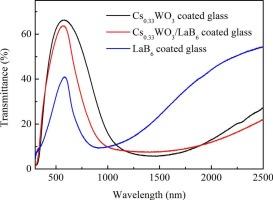High energy-resolution electron energy loss spectroscopy and near infrared absorption study of cesium tungsten bronze and lanthanum hexaboride
IF 2.6
Q3 MATERIALS SCIENCE, MULTIDISCIPLINARY
引用次数: 0
Abstract
Cs0.33WO3 nanoparticles exhibit strong localized surface plasmon resonance (LSPR), making them effective at absorbing near-infrared (NIR) light. However, effectively tuning the optical absorption of Cs0.33WO3 in the critical NIR range of 800–1000 nm has remained a major challenge. In this study, we employ aberration-corrected electron microscopy to conduct high-resolution electron energy loss spectroscopy (EELS) on both Cs0.33WO3 and LaB6 nanoparticles, reveal that the surface plasmon resonance in LaB6 nanoparticles occurs at a higher energy than in Cs0.33WO3, allowing LaB6 to absorb NIR light at shorter wavelengths. Based on this, we successfully adjusted the absorption characteristics of Cs0.33WO3 in the range of 800–1000 nm by utilizing the synergistic LSPR tuning of LaB6 nanoparticles.

铯、钨、青铜和六硼化镧的高能分辨电子能量损失光谱及近红外吸收研究
Cs0.33WO3纳米粒子表现出强烈的局部表面等离子体共振(LSPR),使其有效吸收近红外(NIR)光。然而,在800-1000 nm的近红外临界范围内有效调节Cs0.33WO3的光吸收仍然是一个主要的挑战。在本研究中,我们利用像差校正电子显微镜对Cs0.33WO3和LaB6纳米粒子进行了高分辨率电子能量损失光谱(EELS)分析,发现LaB6纳米粒子的表面等离子体共振发生在比Cs0.33WO3更高的能量下,使LaB6能够吸收波长更短的近红外光。在此基础上,我们利用LaB6纳米粒子的协同LSPR调谐,成功调整了Cs0.33WO3在800-1000 nm范围内的吸收特性。
本文章由计算机程序翻译,如有差异,请以英文原文为准。
求助全文
约1分钟内获得全文
求助全文

 求助内容:
求助内容: 应助结果提醒方式:
应助结果提醒方式:


